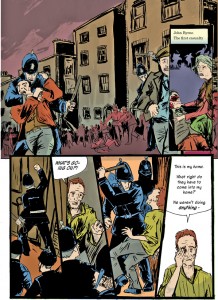
Information on the events of the Lock-Out will not be hard to come by as August 26th draws closer. But in trying to understand watershed events of the past sometimes the human dimension is lost in the politics.
Dublin-based publishers the O’Brien Press, specialists in historical non-fiction and illustrated books for children and adults, have chosen to commemorate the centenary with the release of the graphic novel Big Jim.
Written by Cork-based author Rory McConville and drawn by Dublin designer/cartoonist Paddy Lynch, Big Jim tells the story of the months of the Lock-Out, with a focus upon the dynamic presence of Big Jim Larkin himself.
Rather than overwhelm the reader with dry historical context, the book adopts an immersive, almost thriller-like, storytelling style, directly presenting the poverty and propaganda of the times. The style is documentary-drama, rather than straight documentary.
The project began with McConville pitching to the O’Brien Press, who were enthusiastic. A word-of-mouth recommendation from Dublin-based Marvel Comics artist Declan Shalvey led them to Paddy Lynch and the project took off.
“I write prose and plays,” explained McConville, “but comics have always been a particular passion of mine.” He elaborated that “graphic novels have an atmosphere that just can’t be found in traditional history books. They pull the reader right into the world they’re depicting. In order to fully understand the Lock-Out, you need to be aware of the great suffering and bravery of the people involved.”
For his part, Paddy Lynch, a stalwart of the Dublin comix scene, embarked upon a campaign of research that took him everywhere from the National archives to box-sets of ‘Downton Abbey’ in search of art references. “Using photo reference is always a tricky one in comics, especially with a historical book like Big Jim. You want the characters and places to be recognisable and believable, yet at the same time you don’t want to rob the drawings of the dynamic energy that cartooning has.”
McConville maybe sums up the relationship between the book and the subject best when he observes “It’s appropriate that the Lock-Out be told through a graphic novel because Larkin himself was greatly aware of the power of comics… throughout the Lock-Out, he and William Martin Murphy attacked one another viciously through the political cartoons in Irish newspapers.”
He looks to have had the last word.
by Ruairi Conneely

